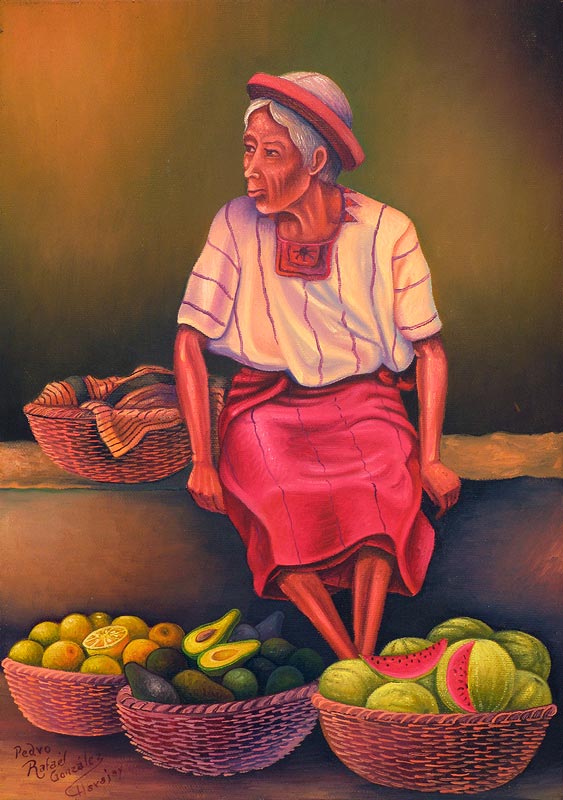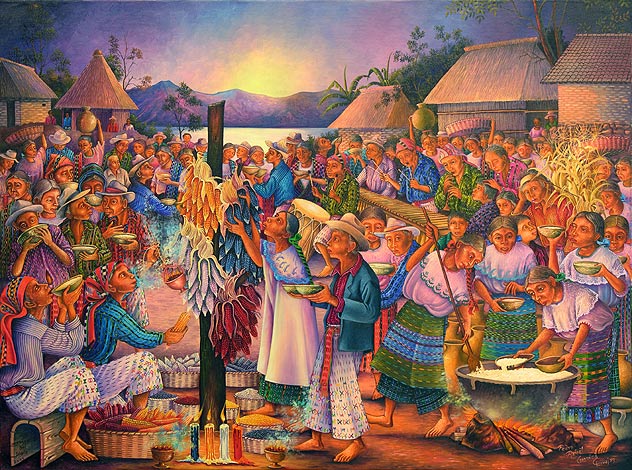Latina/o Heritage Month

Hope” by Pedro Rafaél Gonzáles Chavajay, 2007. (Image courtesy of
Rita Moran, director of Maya Woman: The Helen Moran Collection,
and Joseph Johnston Art Director of Arte Maya Tz’utuhil)
By Michaela Payne/ Copy Editor
Latina/o Heritage Month
City College celebrated Latina/o Heritage Month with a series of events coordinated by Mission center librarian Mauro Garcia.
The United States began recognizing a Hispanic Heritage Week in 1968 and expanded this to a full month in 1988.
Latina/o Heritage Month kicked off on Sept. 15 to commemorate the 1821 declarations of independence by Costa Rica, El Salvador, Guatemala, Honduras and Nicaragua. Mexico’s independence day is celebrated Sept. 16, when Mexico’s revolt for independence began in 1810. The country achieved independence from Spain in 1821. Chile declared independence from Spain on Sept. 18, 1810, and most recently Belize ditched Great Britain’s rule on Sept. 21, 1981.
Honoring Maya Women
Invisible lives of indigenous women are the focus of “She is Everything: Maya Women in the Art of Pedro Rafaél González Chavajay,” a documentary by Rita Moran, who showed the film and lectured about Maya people’s history at the Chinatown center Oct. 13 as part of Latina/o Heritage Month.
Moran taught English as a Second Language (ESL) at City College for nearly a decade and just retired. She now takes filmmaking and digital media classes at the college.
“This is a very City College film,” she said, made in studios and production rooms at Mission and Ocean campuses.
Moran’s film features paintings by González Chavajay and interview footage with the artist, in Spanish with translation voiced by the City College dean and director of Mission center, Jorge Bell, who is originally from Antigua, Guatemala.
Contemporary living painter González Chavajay is the most accomplished artist from his village of San Pedro la Laguna, Guatemala, near Lake Atitlan in the country’s Sololá region.
Working slowly and meticulously, González Chavajay uses vibrant glowing colors to paint handwoven Maya clothing, family, farming, medicinal practices and ceremonies, with a deeply personal expression on each subject’s face.
He learned to paint by shadowing his grandfather and his uncle while they painted people, churches and markets, then developed his own style and even surpassed their technical abilities.
González Chavajay’s work highlights the role of Maya women as priests, as doctors and midwives, as hard workers who rise before anyone else each morning and as survivors of genocide.
“The deeper I got into Maya traditions, the more I began to appreciate women. She is everything,” González Chavajay said in the film (translated from Spanish).
The painter’s reverence for Maya women is clear throughout the paintings shown in Moran’s film, and relates to the ongoing struggle for survival faced by Guatemalan women today.
“This is the most dangerous country in the Americas for women,” Moran said, who cited drug trafficking and corporate mining interests as major threats of violence and displacement to Maya communities today.
Violence remains a prominent issue in Guatemala where a 36-year civil war from 1960 to 1996 claimed 200,000 people who were killed or disappeared – and more than 80 percent were indigenous Maya people who
faced discrimination and displacement. Some survived extreme torture.
Nearly all of the violence was carried out by Guatemala’s government – allied with the United States’ Reagan administration with their practices known by the CIA – which attempted to squash guerrilla revolutionaries in 1982 with a “scorched earth” campaign, destroying homes, crops and drinking water in more than 600 villages, according to The Center for Justice and Accountability based in San Francisco.
During the conflict, violence against women was used as a weapon of war and left a “legacy of violence” CNN reported. Violent acts are still disproportionately directed toward women in “a grisly epidemic,” a United Nations study stated in 2006, largely domestic violence and gang violence related to drug trafficking through Guatemala.
The Guatemala Human Rights Commission called it femicide, meaning violence committed against women just because they are female.
“Women’s corpses are found with signs of sexual abuse and torture. Many victims are left in public places for family and community members to find – a practice that is meant to spread public fear,” the commission reported in 2007.
Several million people fled historically Maya parts of Guatemala during the civil war for the southern México states of Chiapas, Oaxaca and Yucatán Moran said, and as many as 30,000 Mayan people now live in the Bay Area.
Moran geared her presentation toward ESL students who were the majority of the audience. She taught words about Maya culture’s survival with the help of instructors whose students encountered some challenging words for the first time.
“If you take out words like anguish and genocide, you water it down – and how can you understand this without those words?” ESL instructor Bo Huot said. They also learned terms about traditional Mayan identity and livelihood like indigenous, harvest and priest.
“We want our students to learn more about a different culture and new vocabulary – and human rights. That’s what living here is all about,” Chinatown center librarian Mark Fan said.

ESL Level 5 instructor Kate Frei pointed out the accents in part of the artist’s name, “Rafaél González,”
as a lesson for her students to emphasize their pronunciation correctly.
When Moran was teaching at City College, her own ESL students fueled her interest in Guatemalan artists. “I taught them English and they taught me Spanish,” she said.
Moran is the director of her own art collection, featuring 200 paintings by Maya artists in Guatemala. Named the Helen Moran Collection after her mother, a descendent of Irish people who faced similar ethnic discrimination and violence, its purpose is to promote dignity and human rights for indigenous and Latina women through contemporary Maya arts.
Her favorite of González Chavajay’s paintings is titled “Blessing of the Corn” painted in 2005, depicting a gathering of Maya people honoring their most important staple crop. “That was when I fell in love and decided to start collecting them,” Moran said.
Rick Tejada Flores directed and co-produced “She Is Everything.” He has been making Latina/o-centered documentary media for television and cinema for more than 45 years.
Contact a reporter
Send an email to: Michaela Payne

Comments are closed.